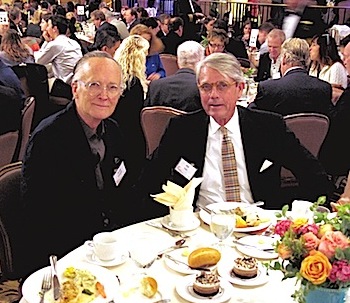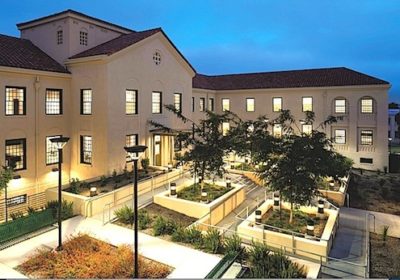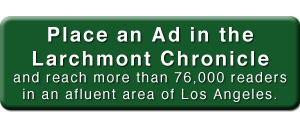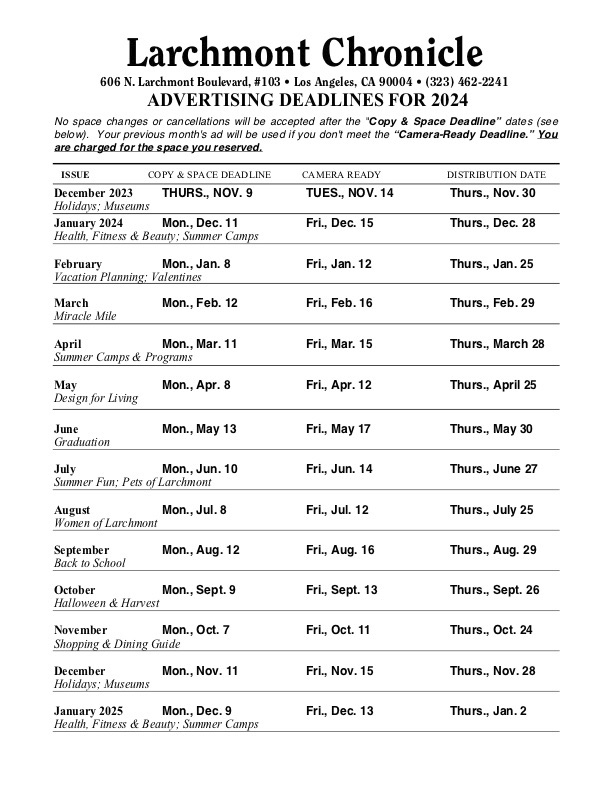Local architect on front lines of VA land planning in Westwood

ARCHITECTS Scott Johnson and Bill Fain at the Los Angeles Conservancy Preservation Awards Luncheon in May 2016.
The long-neglected United States Department of Veteran’s Affairs (VA) campus in Westwood is finally getting a makeover, and Windsor Square resident and architect William Fain, FAIA, of Johnson Fain is helping to lead the charge.
Fain, his wife, Jennifer, and their two grown daughters — Elizabeth Fain LaBombard and Margaret Fain Jenkins — have lived in Windsor Square since 1986. Fain has practiced architecture and urban planning for more than 35 years and is currently the managing partner for Johnson Fain, a firm of 70-plus architects, planners and interior designers, headquartered in downtown Los Angeles.
Focus on urban design
Fain’s long and award-winning career has focused on advancing the practice of urban design as a bridge between the public good and private benefit. He studied for his undergraduate architecture degree at UC Berkeley, attended the University of Manchester in England and then earned his graduate architecture degree from Harvard’s Graduate School of Design in 1975. Fain then went to work as an urban designer in the Office of Midtown Planning and Development of New York City and later served as senior architect and urban designer for the Boston Redevelopment Authority. Before co-founding their firm in 1987 with Scott Johnson, FAIA, Fain worked for Pereira Associates as Director of Urban Design.
With a resume like that, its no wonder that Fain and his firm were approached by lawyers Ronald Olson and O’Malley Miller of Munger, Tolles & Olson LLP, as well as Bobby Shriver of Veteran’s Advocacy, to help develop a master plan for the West Los Angeles VA campus.
Bandini – Jones land

DONA ARCADIA BANDINI Stearns de Baker, 1827-1912, was the great-grandaunt of Carolina Winston Barrie, who long has fought to protect the gift, from Dona Arcadia and Senator Jones, of 387 Westwood acres to provide a permanent home for disabled American war veterans.
The 387-acre property formerly owned by Arcadia Bandini de Baker and Senator John P. Jones, located just west of UCLA and the 405 freeway, was donated by them to the federal government in 1888 They stipulated that the property was to be used as the Pacific Branch of the National Home for Disabled Volunteer Soldiers. If not used for veteran purposes, the property would revert back to the original family ownership.
Over the years, the VA campus has served thousands of veterans as one of the largest medical centers in the VA system. Services include state-of-the-art hospital and outpatient care, rehabilitation, residential care, long-term care, and medical research and education facilities.
Private leases
Beginning in the 1970s, however, the federal government began leasing some of the campus buildings to private entities, and there was increasing neglect and disrepair of many of the other structures and spaces.
“The VA campus went through three periods of growth,” explains Fain. “From the 1800s–1920s, the campus was made up of a ravine filled with sycamores and wide open spaces with sea breezes, homelike architecture, porches and views of the ocean… In addition to the veterans who stayed on the campus, people from West Adams, Bunker Hill and Exposition Park would hop on the streetcar, which terminated at the VA, and come outto picnic on the property.”
The 1920s–1950s saw much more institutionalized growth.
“The buildings weren’t as ‘friendly,’” reports Fain. “They had long corridors and they were more Empire style — plus the VA added different road plans to the campus — which made it hard to figure out where to go.”
In the period from the 1970s–1990s, the campus went through a period of neglect. More than twenty leases were made on the property, including leases to the Brentwood School, UCLA, a solar panel company and many more.
“This was a very opportunistic period and the campus was broken up into parcels,” explains Fain. “It was a time when the federal government as trying to bring in revenue from federally-owned properties.”
Vets and Bandini heir lawsuit
In 2011, the ACLU Foundation of Southern California filed a lawsuit, Valentini v. Shinseki, on behalf of several veterans, the Vietnam Veterans of America and Carolina Winston Barrie (a descendent of Arcadia Bandini de Baker who deeded her land to the United States). Valentini was one of the veterans; Shinseki was the then-Secretary of the VA. The plaintiffs alleged that the VA violated the 1888 deed by misusing part of the campus for commercial purposes.
In 2015, settlement was reached that incorporated a “Principles Agreement,” executed between current VA Secretary Robert McDonald and attorney Ronald Olson. The agreement memorialized the VA’s intent to prepare a new master plan for the campus to make it more Veteran focused.
And that’s where William Fain and his firm, Johnson Fain, came in.
After months of input from veterans and the community during a “Preliminary Draft Master Plan Comment Period” (including more than 100 meetings and over 1,000 responses in the Federal Register), Fain and his firm helped draft a master plan that is, at long last, moving forward.
Draft Master Plan

DRAFT MASTER PLAN for the West Los Angeles VA campus features different zones, with a secure and protected community of permanent supportive housing, with its own neighborhood services, on the “high ground” in the northern part of the property.
The West Los Angeles VA Campus Draft Master Plan recites goals of: providing supportive housing and other services on campus; giving veterans access to a more welcoming and healing environment in which to live and receive care, services and benefits; and working collaboratively among government, veterans, stakeholders and charitable entities to end veteran homelessness in Los Angeles.
The Draft Master Plan brochure lays out the framework for the campus. According to the plan, key features will include Veteran Housing Neighborhoods that have their own supportive housing and neighborhood services, a Town Center located in the geographical center of the campus, and five Neighborhood Centers located throughout the campus that connect to each residential neighborhood.
In May, the Los Angeles Conservancy recognized a beginning part of the plan, architecture firm Leo A. Daly’s award-winning design for the rehabilitation of Building 209 that is located in the supportive housing neighborhood in the northern portion of the Draft Master Plan.
A Reintegration Zone will be located in the current “industrial district,” providing opportunities for education and employment training, plus workshop and gallery space for the arts and an incubator space for nurturing veteran-initiated start-ups.
A Medical District, south of Wilshire Blvd., will provide an array of in-patient and ambulatory care facilities, along with a variety of hospitality facilities for visitors and their families. Open Space and Recreation areas will be offered throughout the campus, including a ballpark and several parks.
Veteran-centric

BUILDING 209 on the VA campus was rehabilitated and adapted into apartment-style units and support facilities for residents. The project recently won a Los Angeles Conservancy Award.
The Draft Master Plan brochure also states that “the framework for development of the West LA Campus envisions a long-term build-out that focuses use of the site on housing and services for veterans, restores and enhances the site’s historic legacy, conserves and repairs its natural setting, and facilitates, encourages and promotes reintegration of veterans into civilian life.”
Though the Draft Master Plan will take years to complete, Fain is confident that things are finally moving in the right direction.
“This master plan is veteran-centric,” says Fain. “Because of the efforts of many vets and their representatives and the descendants of Arcadia Bandini de Baker, this master plan is going to reflect the wishes of the original donors of the property.”
By Sondi Toll Sepenuk
Category: People


